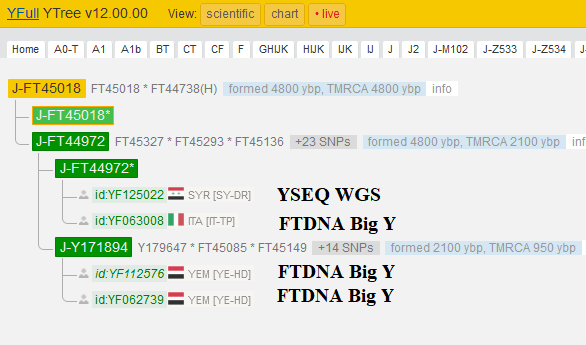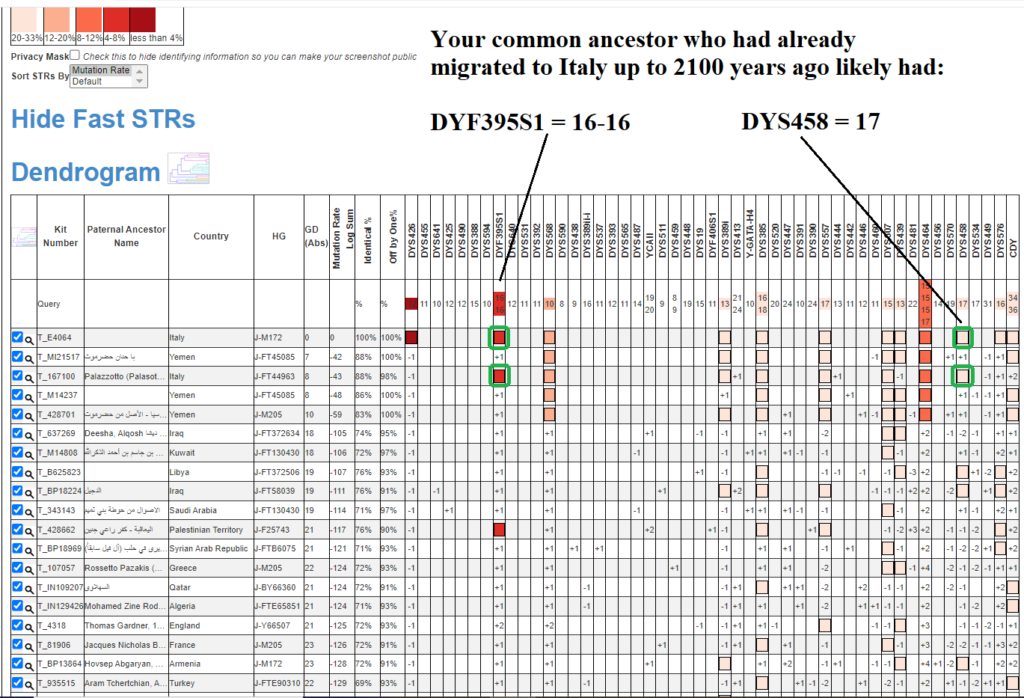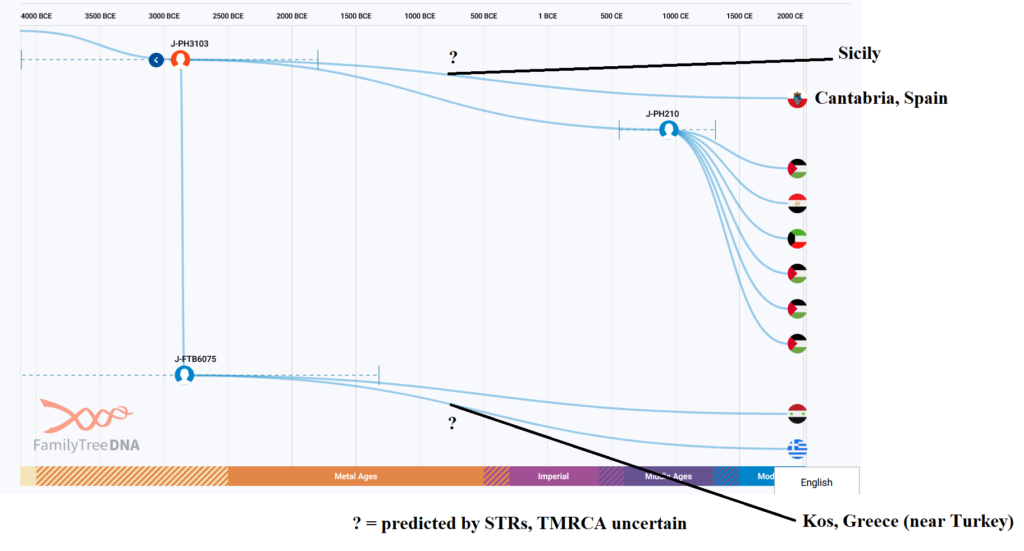I checked the STR matches of samples within Y-DNA haplogroup J2b-M205 which had not done a WGS or Big Y test to determine the exact haplogroup.
Within the Sicily project on FTDNA, there were three such samples. For the samples who had tested 67 and 111 STRs, I was able to confidently predict their next closest relative. In each case, the next closest relative had done a Big Y, so from that association we can predict the subclade of each sample as being the same as their STR match.
J2b-FT44972 with TMRCA 2100 ybp

This branch of the YFull tree contains a YSEQ WGS customer tracing his male line to Dar’a, Syria. It is important to check both the FTDNA tree and the YFull tree to find all samples. The YFull tree has WGS-tested samples, none of which are on the FTDNA tree, and the FTDNA tree has samples who tested Big Y and who did not submit their file to be added to YFull’s tree.
In this case, the sample from Syria may be a reflection of the approximate geographic origin of their Most Recent Common Ancestor (MRCA) who lived about 2100 years ago, or 100 BCE.
Because most of these samples are from West Asia, also incidentally where the oldest related ancient samples have been found, the MRCA was likely living somewhere in West Asia around 100 BCE.
However, if you hover over the light blue text on YFull, you will see “TMRCA CI 95% 2700 <-> 1500 ybp”. This means that YFull computes that there is a 95% chance that the TMRCA lived between 2700 and 1500 years before present.
So the MRCA more likely lived during the time of Roman occupation of Syria and the Levant rather than during the heyday of the Phoenicians earlier in the Iron Age.

Querying on the STR alleles of E4064 from the Sicily project on FTDNA, I find that his closest STR matches are descendants of J-FT44972. Intriguingly, he is not a close match to the other Italian sample, also from the Sicily project, but they do share two rare STR alleles in common, DYF395S1 = 16-16 and DYS458 = 17.
Because the other men confirmed by Big Y or WGS tests to be in this subclade do not have those alleles, I predict that both Sicilian men descend from a more recent common ancestor who had these alleles, who may have lived a few hundred years after the MRCA with the other West Asian men. We might assume that this ancestor sired both lineages in Sicily, though a migration of related men is also possible.
In this case, I think a Roman era migration is more likely based on the estimated TMRCA, though Phoenician-mediated migration probably should not be ruled out given the wide confidence interval. The ancestor who migrated likely reflected what was common among the populations of Syria or the Levant at that time.
J2b-PH3103 TMRCA 5000 ybp


The relationship between Aceto from Sicily and the sample from Cantabria, Spain is very reliable on the basis of sharing so many rare alleles, despite having so many differences that they do not show up within FTDNA as each other’s matches (that’s why I developed STR Match Finder by the way). The STRs are ordered left to right from most to least stable.
I do not generally try to predict TMRCA from STR differences because it is very unreliable. But given that the TMRCA of J2b-PH3103 is 5000 years ago, this line could possibly represent a Phoenician migration to Sicily, and later to Spain (because the time of the Phoenicians was much later).
By the way the additional sample from Kos, Greece that I inserted into the Time Tree for J2b-PH3103 I reliably predict as J2b-PH3103 but the relationship to the other Greek is not as reliable. The comparison was made against 67 STRs and they only share a rare DYS464 and have a slightly lower genetic distance to one another than to their next closest relatives. Kos has links to Phoenicians by proximity and Phoenician wine amphorae were found in a shipwreck there.
https://www.alteroemer.de/en/phoenician-wine-amphora.html
J2b-M205 Possibly Diversified with the Uruk Expansion
For some background information about Y-DNA haplogroup J2b-M205 and my theory of it having likely diversified as a result of the Uruk Expansion, check out this video: